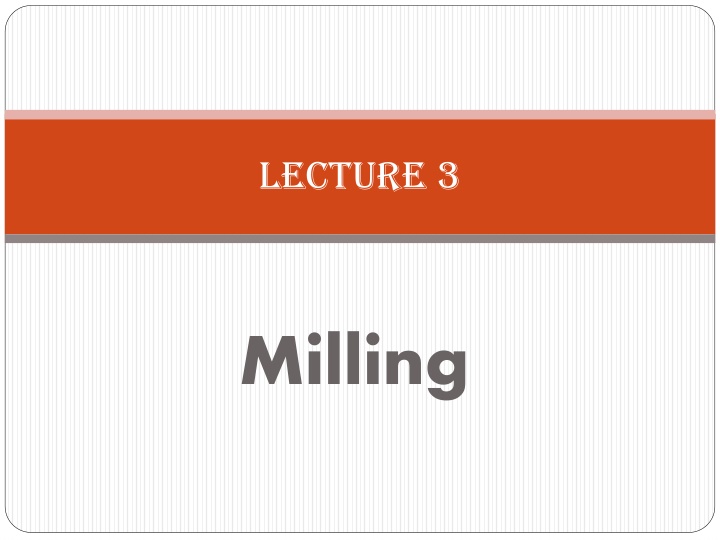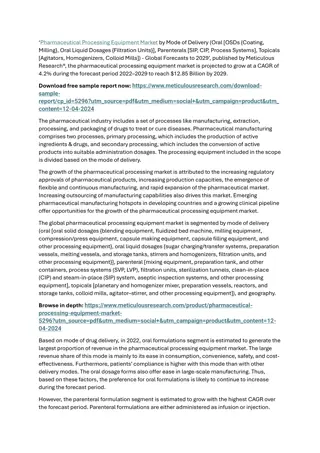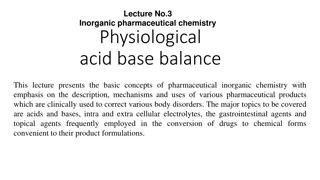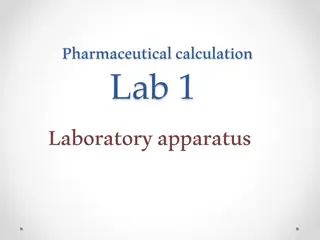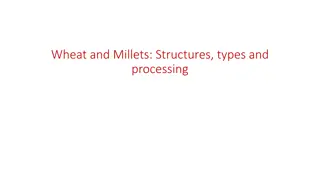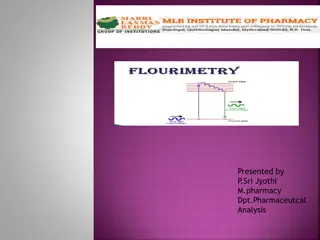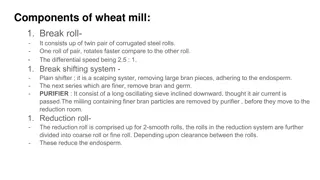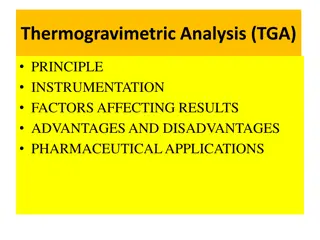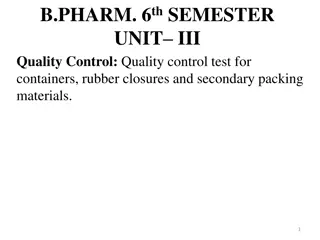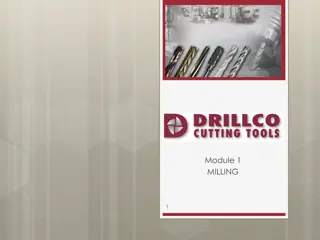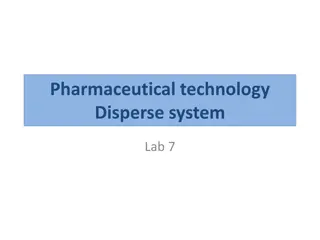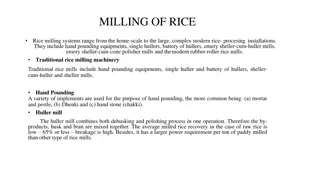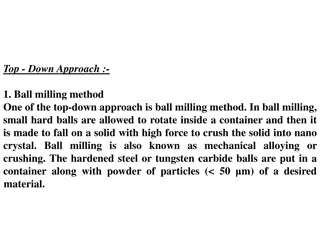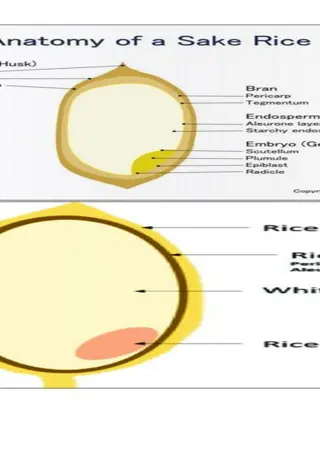Factors Influencing Milling Process in Pharmaceutical Industry
Factors influencing the milling process in the pharmaceutical industry include the physical nature of materials, heat during milling, shape of milled particles, selection of milling equipment, versatility of operation, dust control, sanitation, auxiliary equipment, batch or continuous operation, and economical factors. Various considerations such as material properties, moisture content, and capacity of the mill impact the choice of milling equipment to achieve the desired particle size and distribution. Safety concerns, sanitation, and cost efficiency also play a crucial role in the milling process.
Download Presentation

Please find below an Image/Link to download the presentation.
The content on the website is provided AS IS for your information and personal use only. It may not be sold, licensed, or shared on other websites without obtaining consent from the author.If you encounter any issues during the download, it is possible that the publisher has removed the file from their server.
You are allowed to download the files provided on this website for personal or commercial use, subject to the condition that they are used lawfully. All files are the property of their respective owners.
The content on the website is provided AS IS for your information and personal use only. It may not be sold, licensed, or shared on other websites without obtaining consent from the author.
E N D
Presentation Transcript
Lecture 3 Milling
Factors Influencing Milling The properties of solids determine: 2- Ability to resist size reduction. 1- choice equipment of milling. e.g. Hard material (iodine) is abrasive rapid wear of mill parts immediately during size reduction.
1- Physical nature of material E.g. A- fibrous material (glycyrrhiza) crushed by cutting (cannot be crushed by pressure or impact). B- Friable materials (sucrose) fracture by attrition, pressure. impact, 2- Hygroscopic materials (CaCl2) rapidly sorb moisture wet mass sticks and clogs the mill. B- Materials contain > 50% water produce slurry or fluid suspension E.g. A- Materials contain > 5% water produce sticky mass in fine powder rather than large particles. (wet milling for size reduction). Note:Increase moisture Alter crystalline structure and chemical changes in some materials (crystal growth and caking). E.g.: Cortisone acetate equilibrate with aq. vehicle) decrease rate of milling to a specified product size
3- Heat [during milling] softens and melts materials with low melting points C- Pigments (sienna) change their shade of color in excessive temp. E.g. A- Synthetic gums, waxes and resins becomes soft and plastic. D- Unstable and fine powders ignite and explode at high temp. B- Heat sensitive drugs degraded or charred. 4- Shape of milled particles E.g. A- Impact mill (produce sharp or irregular particles) [not flow readily] B- Attrition mill (produce spherical particles) [free- flow]
Selection of a Mill Materials used in pharmaceuticals reduced in particle size less than 40 mesh size by (Hammer, ball, roller, fluid-energy mills) Choice of mill based on: 1- Product specification Size range particle size distribution shape moisture content physical and chemical properties of materials 2- Capacity of mill and production rate requirements.
3- Versatility of operation Wet and dry milling Rapid change of speed and screen Safety features 4- Dust control Loss of costly drugs Health hazards Contamination of plant 5- Sanitation Ease of cleaning sterilization
6- Auxiliary equipment Cooling system Dust collectors Forced feeding Stage reduction 7- Batch or continuous operation 8- Economical factors Cost Power consumption Space occupied Labor cost
Techniques of milling Standard adjustments of milling process 1. Speed 2. Screen size 3. Design of rotor 4. Load 5. Special atmosphere E.g. A-Hygroscopic materials (closed system with dehumidifier air). B- Thermolabile, easily oxidized, combustible materials (closed system with inert atmosphere of CO2or nitrogen. C- Fine dust like sulfur is potential explosive (explosion proof and the mill grounded).
6. Temp. Control (Bulk of energy is converted into heat unless controlled because solid will melt, decompose or explode). [To avoid this, the milling chamber cooled by cooling jacket or heat exchanger]. E.g. Waxes and low melting point materials (beeswax and stearic acid) chilled before milling (with hammer mill to 100 mesh size) and if not sufficient add dry ice with feeder. 7. Pretreatment (Mills operate satisfactory when the feed is in the proper size and enter at a fairly uniform rate). E.g. Pretreatment of fibrous materials with high-pressure rolls or cutters facilitates comminution.
8. Subsequent Treatment (Extreme control of size is necessary to recycle large particles) in 2 ways: Simply screening discharge and returning particles for 2nd milling Using air-separation equipment in a closed circuit to return oversized particles automatically to the milling chamber. oversized 9. Dual Process (Milling process is simultaneously as a mixing process) E.g. Fluid-energy mill (used for size reduction and dispersion) Hot gas circulated through the mill to comminute and to dry moist solids after coating with monomolecular film by premixing with 0.25% coating agent simultaneously.
10. Wet and Dry Milling (Choosing milling type depends on the use of the product and subsequent processing). A- Dry Milling (for the products undergoes physical and chemical changes in water -fineness in the region of 100 micron-). Note: Dispersing agents in dry grinding (calcium stearate and oleic acid) useful in revolving of mill if coating of balls occur. B- Wet Milling (for further reducing the size but flocculation lowers the limit to 10 micron). Benefits:Eliminate dust hazards and done in low speed that consumes low power. Note: Dispersing agents in wet grinding like (Silicate and phosphates).
